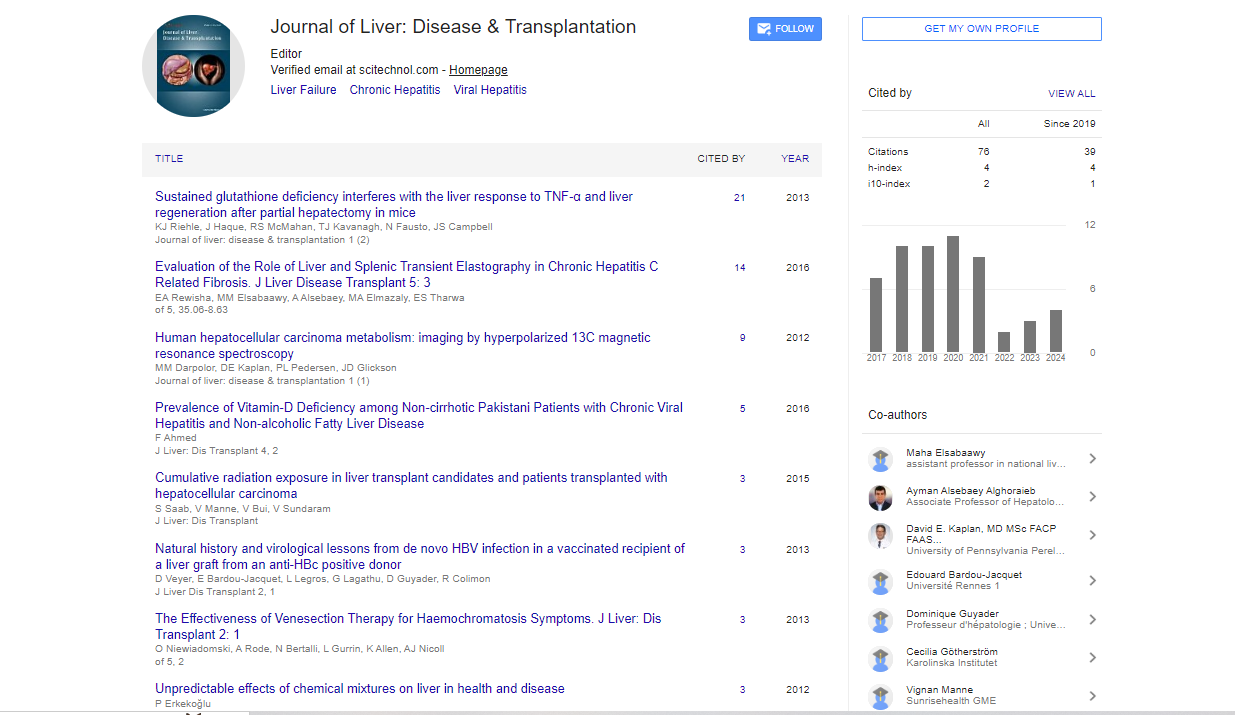Opinion Article, J Liver Disease Transplant Vol: 13 Issue: 2
Optimizing Immunosuppressive Therapy in Post Transplantation Care: Balancing Efficacy and Safety
Gofes Jenk*
1Department of Gastroenterology, Federal University of Sao Paulo, Sao Paulo, Brazil
*Corresponding Author: Gofes Jenk,
Department of Gastroenterology, Federal
University of Sao Paulo, Sao Paulo, Brazil
E-mail: jenkgof@esedu.br
Received date: 27 May, 2024, Manuscript No. JLDT-24-146989;
Editor assigned date: 30 May, 2024, PreQC No. JLDT-24-146989 (PQ);
Reviewed date: 13 June, 2024, QC No. JLDT-24-146989;
Revised date: 21 June, 2024, Manuscript No. JLDT-24-146989 (R);
Published date: 28 June, 2024, DOI: 10.4172/2325-9612.1000266
Citation: Jenk G, (2024) Optimizing Immunosuppressive Therapy in Post Transplantation Care: Balancing Efficacy and Safety. J Liver Disease Transplant 13:2
Description
Immunosuppressive therapy is important in post-transplantation care, essential for preventing organ rejection and ensuring the long term success of the transplant. However, balancing efficacy with safety is a complex challenge. Effective immunosuppression must prevent rejection while minimizing adverse effects and complications. Immunosuppressive therapy aims to prevent the recipient's immune system from attacking the transplanted organ. The therapy typically involves a combination of drugs that target different aspects of the immune response. Drugs like tacrolimus and cyclosporine inhibit T-cell activation, a key process in the immune response against the graft. Tacrolimus is preferred due to its more favorable side effect profile compared to cyclosporine. Medications such as Mycophenolate Mofetil (MMF) and azathioprine inhibit Deoxyribonucleic Acid (DNA) synthesis in rapidly dividing cells, including lymphocytes.
MMF is commonly used due to its efficacy and better tolerability compared to azathioprine. Corticosteroids like prednisone are used for their broad anti-inflammatory effects. They are effective in managing acute rejection episodes but are associated with numerous side effects, including diabetes, hypertension and osteoporosis. Agents like basiliximab and alemtuzumab target specific immune cells or pathways. These drugs are often used in combination with other immunosuppressants to enhance efficacy and reduce the dose of other drugs. Optimizing immunosuppressive therapy involves balancing the need to prevent organ rejection with the risk of drug toxicity and other side effects. Each transplant recipient responds differently to immunosuppressive medications. Individualizing therapy based on the recipient's specific needs, including the type of organ transplanted, the recipient's overall health and the potential for drug interactions, is important.
Monitoring drug levels through Therapeutic Drug Monitoring (TDM) helps adjust dosages to achieve optimal efficacy while minimizing toxicity. Long-term use of immunosuppressive drugs can lead to serious side effects. Strategies to minimize these effects include using lower doses of drugs, switching to less toxic alternatives and implementing preventive measures. For instance, calcineurin inhibitors can cause nephrotoxicity; thus, monitoring renal function and adjusting dosages are essential to prevent kidney damage. Transplant recipients often take multiple medications, increasing the risk of drug interactions. Clinicians must carefully manage these interactions to avoid adverse effects and ensure optimal drug levels. For example, certain antibiotics can affect the metabolism of immunosuppressive drugs, requiring dosage adjustments.
Immunosuppressive therapy increases the risk of infections, which are a leading cause of morbidity and mortality in transplant recipients. Prophylactic antibiotics, antiviral drugs and regular screening for infections are essential to manage this risk. Balancing immunosuppression to prevent rejection while minimizing infection risk is a key aspect of post-transplant care. Regular monitoring of organ function, drug levels and potential side effects is essential. Routine assessments, including blood tests and imaging studies, help detect early signs of rejection or toxicity. Adjusting therapy based on these findings helps maintain a balance between preventing rejection and avoiding adverse effects. Ensuring that patients understand the importance of medication adherence and the potential side effects of their treatment is vital for optimizing therapy. Education about medication schedules, recognizing signs of complications and the importance of regular follow-up visits can significantly impact treatment outcomes.
Conclusion
Optimizing immunosuppressive therapy in post-transplantation care is preventing organ rejection and minimizing adverse effects. Individualized treatment plans, careful monitoring and patient education are essential components of successful management. As study progresses, advancements in drug therapies and monitoring techniques will likely offer even better strategies for achieving this balance, ultimately improving the quality of life for transplant recipients.
 Spanish
Spanish  Chinese
Chinese  Russian
Russian  German
German  French
French  Japanese
Japanese  Portuguese
Portuguese  Hindi
Hindi 